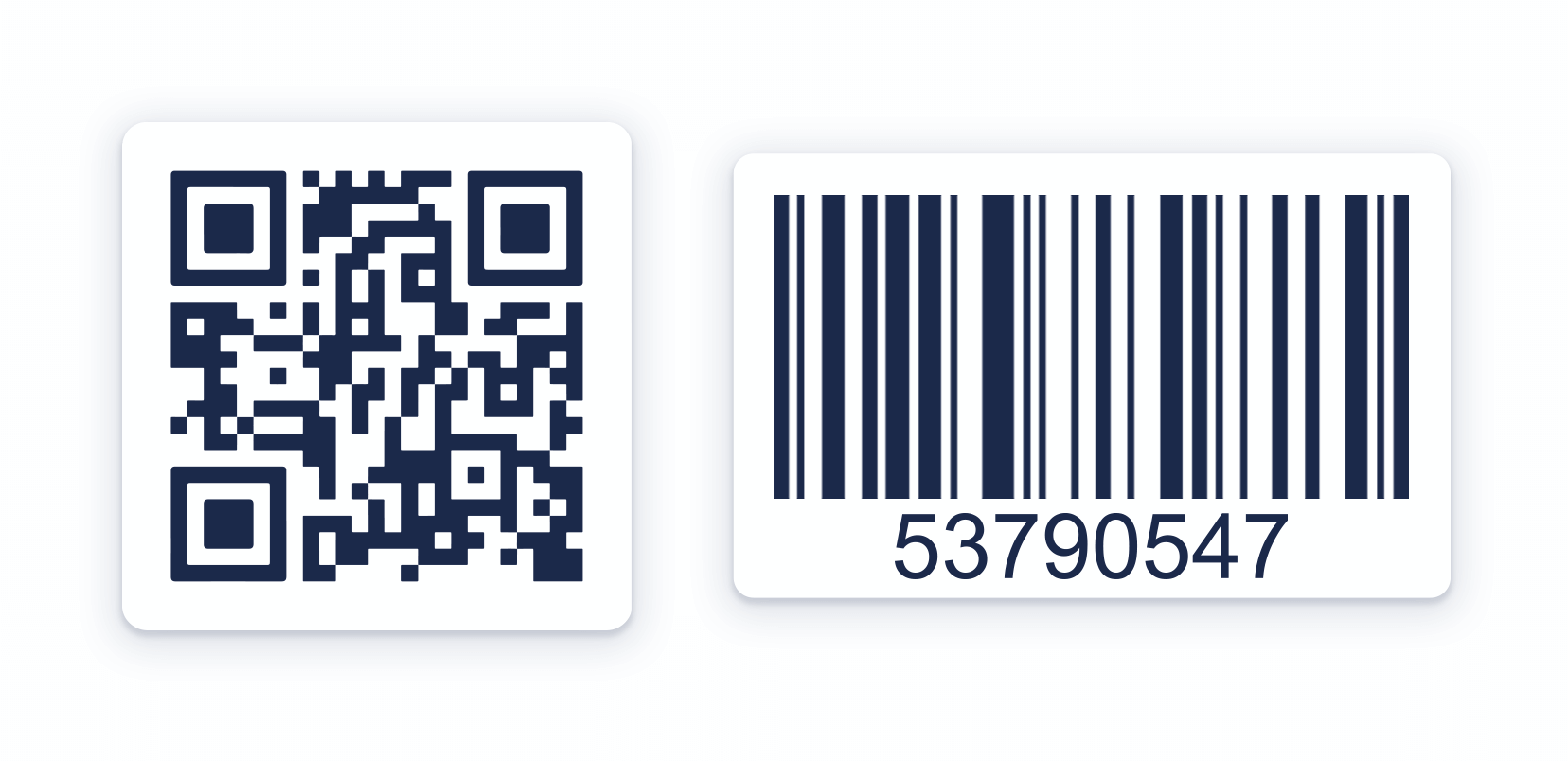What is a QR Code?Before we delve into the history of a QR Code, let’s make sure it’s clear what a QR Code is. A QR Code, or quick response Code, is a Code that is quickly readable by a cell phone (hence the word “quick” in the name). Using a combination of spacing as a type of Matrix Barcode (a 2-D Barcode), when a QR Code is scanned, it conveys a wide multitude of information. QR Codes have a wide range of uses across all types of industries such as retail, marketing, and logistics.QR Codes vs BarcodesWhile QR Codes and Barcodes are similar in practice, QR Codes contain more information because they have the ability to hold information both horizontally and vertically. Barcodes only use horizontal information. While Barcodes work wonderfully for situations like scanning supermarket items, QR Codes have a much higher capability of transferring information, likely what has made them increasingly popular due to their versatility. Life before Barcodes and QR CodesLike the development of many technologies, QR Codes were created out of necessity. QR Codes actually started out as Barcodes with their typical purpose: for supermarkets. In the 1960s, Japan was experiencing a wave of economic growth. Supermarkets expanded from selling just food items to adding in clothing and a versatile range of other commodities. So, they basically realized that they needed a way to keep track of everything.Before Barcodes existed, cashiers had to manually enter individual items (can you imagine?!), which of course took ages. Due to the health issues created as a result of these heavily repeated actions like carpal tunnel syndrome, supermarket managers knew they needed to find a solution.The Point of Sale (POS) systemAs a result of the growing demand for technology to lighten the burden on supermarket cashiers, a POS system was created. It was basically the newborn baby version of a Barcode that allowed for the scanning of individual items to be registered by a computer. Despite this effort, however, this still wasn’t enough. Supermarkets then faced another obstacle: Barcodes could only store up to around 20 alphanumeric characters of information and functioned with one dimension (one direction of coding).The involvement of DENSO WAVE INCORPORATEDThe invention of the QR Code can be contributed to the DENSO WAVE and their lead developer Masahiro Hara. They were contacted by supermarkets who realized the limits of these Barcodes and sought a way to make them more versatile and contain more information through the development of a 2-D Code (two directions of coding).
Life before Barcodes and QR CodesLike the development of many technologies, QR Codes were created out of necessity. QR Codes actually started out as Barcodes with their typical purpose: for supermarkets. In the 1960s, Japan was experiencing a wave of economic growth. Supermarkets expanded from selling just food items to adding in clothing and a versatile range of other commodities. So, they basically realized that they needed a way to keep track of everything.Before Barcodes existed, cashiers had to manually enter individual items (can you imagine?!), which of course took ages. Due to the health issues created as a result of these heavily repeated actions like carpal tunnel syndrome, supermarket managers knew they needed to find a solution.The Point of Sale (POS) systemAs a result of the growing demand for technology to lighten the burden on supermarket cashiers, a POS system was created. It was basically the newborn baby version of a Barcode that allowed for the scanning of individual items to be registered by a computer. Despite this effort, however, this still wasn’t enough. Supermarkets then faced another obstacle: Barcodes could only store up to around 20 alphanumeric characters of information and functioned with one dimension (one direction of coding).The involvement of DENSO WAVE INCORPORATEDThe invention of the QR Code can be contributed to the DENSO WAVE and their lead developer Masahiro Hara. They were contacted by supermarkets who realized the limits of these Barcodes and sought a way to make them more versatile and contain more information through the development of a 2-D Code (two directions of coding). With only two team members, Hara first came up with the idea of the square, because their research showed that it was an easily distinguishable shape. This shape additionally allowed for both horizontally and vertically Coded information. A further advantage was that this also boosted the speed at which this information could be read (up to 10x faster than Barcodes). The combination was a jackpot. DENSO WAVE made their invention of the QR Code public in 1994 without maintaining patent rights and the use of QR Codes spread like wildfire.How did QR Codes become popular?QR Codes found their first use in Japan’s Kanban, which is a type of electronic communication tool used in the automotive industry. They quickly recognized the versatility that QR Codes offered and began to use them in everything from production and shipping, as well as for transactions. Following the subsequent societal demand for more traceability for products, particularly for the food and pharmaceutical industries, these industries realized how they could use QR Codes provided their businesses with an indispensable advantage. As a result of Hara’s decision not to keep patent rights, QR Codes found their uses into people’s daily lives. Later on, in 2000, QR Codes were added to ISO international standards. This allowed them to basically be used across the globe. Later on, with the invention of the smartphone, there was no stopping the increasing rate of QR Code’s popularity.Other types of QR CodesThere are actually many types of both Barcodes and QR Codes in use for many reasons. Here are a few of the most popular versions:QR Codes found even further uses through the development of micro QR Codes, or Codes that small enough to fit on smaller items so they don’t take up space. However, they do have the limitation that they hold less information than regular QR Codes.
With only two team members, Hara first came up with the idea of the square, because their research showed that it was an easily distinguishable shape. This shape additionally allowed for both horizontally and vertically Coded information. A further advantage was that this also boosted the speed at which this information could be read (up to 10x faster than Barcodes). The combination was a jackpot. DENSO WAVE made their invention of the QR Code public in 1994 without maintaining patent rights and the use of QR Codes spread like wildfire.How did QR Codes become popular?QR Codes found their first use in Japan’s Kanban, which is a type of electronic communication tool used in the automotive industry. They quickly recognized the versatility that QR Codes offered and began to use them in everything from production and shipping, as well as for transactions. Following the subsequent societal demand for more traceability for products, particularly for the food and pharmaceutical industries, these industries realized how they could use QR Codes provided their businesses with an indispensable advantage. As a result of Hara’s decision not to keep patent rights, QR Codes found their uses into people’s daily lives. Later on, in 2000, QR Codes were added to ISO international standards. This allowed them to basically be used across the globe. Later on, with the invention of the smartphone, there was no stopping the increasing rate of QR Code’s popularity.Other types of QR CodesThere are actually many types of both Barcodes and QR Codes in use for many reasons. Here are a few of the most popular versions:QR Codes found even further uses through the development of micro QR Codes, or Codes that small enough to fit on smaller items so they don’t take up space. However, they do have the limitation that they hold less information than regular QR Codes. The structure of a QR CodeThe modern-day QR Code consists of 7 parts. Each of these parts creates a sort of pixel pattern that looks similar to a crossword puzzle. Each element has a specific purpose that conveys certain information through the Code such as the print direction, timing, error tolerance, and empty spaces to differentiate the Code from what surrounds it. Here is a complete overview.How to scan QR CodesThese days, the majority of QR Codes are scanned with a smartphone. There are tons of free apps for QR scanning for both Android and iOS devices(also with the camera). Most often, you simply open the app and it automatically scans the QR Code with the touch of a button. QR Codes in business
The structure of a QR CodeThe modern-day QR Code consists of 7 parts. Each of these parts creates a sort of pixel pattern that looks similar to a crossword puzzle. Each element has a specific purpose that conveys certain information through the Code such as the print direction, timing, error tolerance, and empty spaces to differentiate the Code from what surrounds it. Here is a complete overview.How to scan QR CodesThese days, the majority of QR Codes are scanned with a smartphone. There are tons of free apps for QR scanning for both Android and iOS devices(also with the camera). Most often, you simply open the app and it automatically scans the QR Code with the touch of a button. QR Codes in business One of their most popular uses is QR Codes for business cards. This could come in handy, for example, when you are at a networking event and need to speak with many people in a short period of time. Many business people are familiar with the large stack of business cards you carry around after these types of events, but QR Codes provide an improved solution. You can add a vCard Plus QR Code that makes it simple to upload the details of a business card directly to a smartphone. An additional advantage is that you are now not limited to the space allowance on a traditional business card. With a digital version, potential clients or partners can view you on social media and get additional detail like your office hours or book an appointment directly.
One of their most popular uses is QR Codes for business cards. This could come in handy, for example, when you are at a networking event and need to speak with many people in a short period of time. Many business people are familiar with the large stack of business cards you carry around after these types of events, but QR Codes provide an improved solution. You can add a vCard Plus QR Code that makes it simple to upload the details of a business card directly to a smartphone. An additional advantage is that you are now not limited to the space allowance on a traditional business card. With a digital version, potential clients or partners can view you on social media and get additional detail like your office hours or book an appointment directly.




